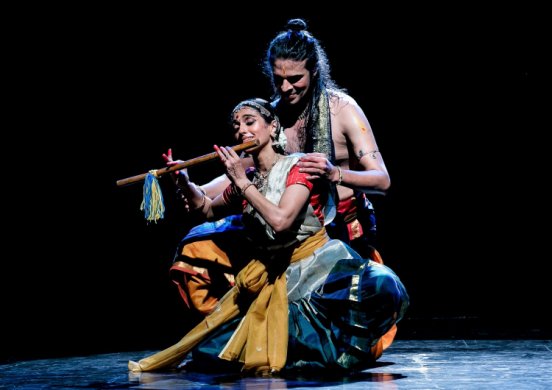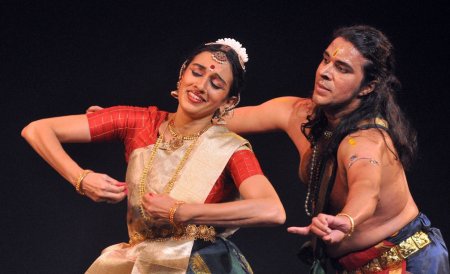
|   |

|   |
 e-mail: leelakaverivenkat@gmail.com Magic Bow's enchanting delve into mind of music composer Photos courtesy: JustUs Repertory February 10, 2023 To how many people is given the blessing of looking into the mind of a music genius, about what has inspired his creations? Was it a thought process or visual images that spoke to him through melodic phrases? To Gowri Ramnarayan, was given the great good fortune, in her many close interactions with the Carnatic music savant Lalgudi Jayaraman, of delving into the recesses of his mind, to form an impression of the kind of images inspiring some of his compositions. And as a creative person, the temptation to pattern a Bharatanatyam performance based on Lalgudi Jayaraman's creations, re-visualised with the scenarios in the creator's mind while giving birth to these compositions, became over powering. And what better combination could one have, than Sheejith Krishna's fertile choreographic mind, with him and Anjana Anand as the dancing twosome, under Gowri's direction and script, visualising the programme, premiered at Kalakshetra's Rukmini Arangam, Chennai?  Sheejith Krishna & Anjana Anand The poetry of melody that Lalgudi Jayaraman's bow produced, enraptured listeners, and for any presentation based on his compositions, the accompanying music has to be of the highest quality. And in the soulful vocal renderings in the sound track with Nisha Rajagopalan's singing voice, accompanied by Shreya Devnath on the violin and Vishnu Vijay on the flute, with Sheejith Krishna himself providing mridangam percussion, full musical justice was done to the creations. The presentation, with moderator Gowri Ramnarayan began with Jatiswaram in Rasikapriya, showing Lalgudi's preference for unusual ragas. While this raga has all the eight swaras, the placing of the notes can create a dissonant quality of unevenness and when questioned about what went on in his mind before embarking on this Jatiswaram, Lalgudi had spoken about the images of stormy skies and the boat with a couple, caught in the rough, tossed about on the choppy waters, till a stage comes with greater calm when in the distance a boat is seen coming to their rescue. To suggest this entire imagery while performing the Jatiswaram, with only solfa syllabic combinations and no sahitya, could only have been accomplished by an imaginative mind like Sheejith's. Rather than the rakti ragas like a Bhairavi, a Todi or Shankarabharanam, varnam compositions of the maestro were in ragas like Mohanakalyani, Devagandhari, Nalinakanti, Huseni. And his varnam in Charukesi became one of the most sought after by Bharatanatyam dancers. In "Innum en manam ariyadavarpol" the nayika/devotee gently chides Krishna for pretending not to know her mind. Not built round any of the known episodes on Krishna, the varnam only hints at this butter stealer, teaser of young girls, who is there one minute and gone the next. "Oh charmer with the flute, please relieve me of all my trials" she calls out to Krishna in the charanam line. Gowri mentioned in her introduction, how the maestro spoke of that closeness to Krishna so potent one minute and missing the next. Like switching on the lights, the closeness to Krishna, illuminating your consciousness one minute, and then suddenly the light fades. This varnam is a call to that Krishna within to be ever present. The nayika battling with this constant byplay of appearances and disappearances, is caught with masterly craftsmanship in the dance rendition. The devotee runs to greet him in front but suddenly finds he has receded. Drawn to a peacock feather, or the flute or his pitambar cloth on the ground, surrounded by flute music sounds as waves of ecstasy wash over her, she runs looking for him - only to find it is all a mirage. With both performers giving an involved presentation, the byplay of constant hide and seek with the teermanam punctuations rendered together against the backdrop of the delightful music made the varnam presentation very absorbing.  Sheejith Krishna & Anjana Anand The next scene was based on images from Lalgudi's village in Trichy district, where the day starts early and which the vidwan said had left its strong imprint on his mind, of the beauty of nature, of art and of the power of a melodic mode. With the sunrise, the air is filled with sounds of the bullock carts moving, with the singing of the goatherd with his flock. Walking to the temple in the village every day (and here Gowri uses her own imagination, about listening to a dancer performing it) and what follows is one of Lalgudi's Pancharatna kritis Mahita pravruddha shrimati in Kambhoji ragam, tisratriputa talam. Anjana appears briefly as a dancer while Sheejith is the devotee (Lalgudi?) singing before the Goddess who is addressed as the Mother of Subrahmanya and Ganapati, consort of Shiva, and daughter of Himavan, the Mother of virtues who is described as 'the peacock to the snake of worldly existence'. The scenes with sensitive lighting apart, the delightful singing evokes an ambience of quietude. The concluding part in Tillana, highlights the versatility of this musical genius, tracing his lineage from a disciple of the incomparable Thyagaraja himself, his creative ambit embracing ragas from the Hindustani classical tradition. His Tillanas in ragas like Durga, Maand, Desh, Bageshree, Tilang proved this. In this instance, in consonance with his love for Nature (Gowri mentioned his speaking of green as creating a sense of peace, and of how the colours of Nature spoke to him), she chose Lalgudi's Tillana in Pahadi and wondered if his mind had been drawn to mountains and snow clad slopes and after this was rendered the finishing touch through Tiruppugazh in Hameer Kalyani set to chaturasra ekam. A unique evening of Bharatanatyam comprising a rare peep into the mind of a composer, whose music, even in his physical absence, will play on as long as Carnatic music exists!  Writing on the dance scene for the last forty years, Leela Venkataraman's incisive comments on performances of all dance forms, participation in dance discussions both in India and abroad, and as a regular contributor to Hindu Friday Review, journals like Sruti and Nartanam, makes her voice respected for its balanced critiquing. She is the author of several books like Indian Classical dance: Tradition in Transition, Classical Dance in India and Indian Classical dance: The Renaissance and Beyond. Post your comments Pl provide your name and email id along with your comment. All appropriate comments posted with name and email id in the blog will also be featured in the site. |